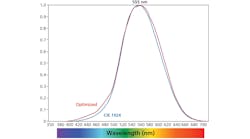Luminance is the luminous intensity per unit emitting area for a non-point source. To the observer, the property of luminance corresponds to the brightness of the source. Luminance is measured in units of candela/square meter (cd/m2), equivalent to nit.
For white LEDs, Lumileds has reported a luminance of 38 mega nit (Mcd/m2), approximately 50% higher than an automotive headlamp halogen bulb (approximately 25 Mnit). Note that 38 Mcd/m2 is equivalent to 38 cd/mm2, and for a 1 mm2 source area the output would be 38 cd.
For InGaN green devices, Lumileds reported a luminance of 37 mega nits (Mcd/m2) was achieved, while for InGaN blue LEDs, a radiance of 200 mW/sr.mm2 was reported. (Radiance is the radiant intensity per unit area; radiometric units are used for blue LEDs since their output is at the limit of human vision where photometric units such as lumens and luminance can be used).
Philips Lumileds says that the results demonstrate light output performance levels well beyond what is possible from today's state-of-the-art LEDs and are indicative of the company's evolutionary R&D work that will significantly affect the performance and design of light-intensive applications such as automotive headlamps, rear-projection televisions (RPTV), and commercial lighting.
In the automotive headlamp arena, new white LED products based on these advances will generate light density exceeding that of the halogen bulb commonly used in automotive headlamps and require a fraction of the physical space. High precision mounting and alignment of the new products in development will yield better light control, resulting in significantly smaller and more efficient headlamps than those built with conventional technologies. Combined with higher visibility white performance, LEDs will change the shape of automotive forward lighting.
LED RPTVs, one of the most talked-about consumer technologies at this year's CES in Las Vegas, are limited in brightness by the light output of current LEDs. Philips Lumileds anticipates that the luminance demonstrated with its new technologies will enable front-of-screen performance brighter than any LED-based RPTV that has been publicly demonstrated. The new solid-state devices would also remove barriers to increased display size, and superior contrast and color uniformity. The entire system is improved and the viewers' experience enhanced with improved color gamut, lower profile systems, longer lifetime and reduced ownership costs.
In the lighting category, applications such as aircraft, roadway and general lighting will benefit from the greatly improved light output performance and the innate ability of solid-state lighting to operate in very cold environments, withstand significant shock and vibration, and be controlled digitally.




